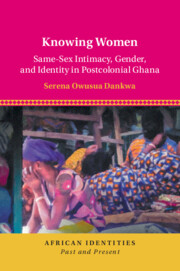Book contents
- Knowing Women
- African Identities: Past and Present
- Knowing Women
- Copyright page
- Dedication
- Contents
- Figures
- Acknowledgments
- Prologue: Arrival Stories
- Introduction: Freeing Our Imaginations
- 1 Tacit Erotic Intimacies and the Culture of Indirection
- 2 Supi, Secrecy, and the Gift of Knowing
- 3 “The One Who First Says ‘I Love You’”
- 4 Sugar Motherhood and the Collectivization of Love
- 5 “Doing Everything Together”
- Conclusion: A Fabric that Never Goes Out of Fashion
- Bibliography
- Index
- References
Bibliography
Published online by Cambridge University Press: 07 January 2021
- Knowing Women
- African Identities: Past and Present
- Knowing Women
- Copyright page
- Dedication
- Contents
- Figures
- Acknowledgments
- Prologue: Arrival Stories
- Introduction: Freeing Our Imaginations
- 1 Tacit Erotic Intimacies and the Culture of Indirection
- 2 Supi, Secrecy, and the Gift of Knowing
- 3 “The One Who First Says ‘I Love You’”
- 4 Sugar Motherhood and the Collectivization of Love
- 5 “Doing Everything Together”
- Conclusion: A Fabric that Never Goes Out of Fashion
- Bibliography
- Index
- References
Summary
- Type
- Chapter
- Information
- Knowing WomenSame-Sex Intimacy, Gender, and Identity in Postcolonial Ghana, pp. 280 - 302Publisher: Cambridge University PressPrint publication year: 2021
- Creative Commons
- This content is Open Access and distributed under the terms of the Creative Commons Attribution licence CC-BY-NC-ND 4.0 https://creativecommons.org/cclicenses/



